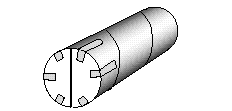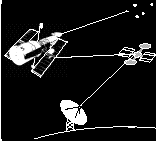Paper tube (mailing tube, tube
from a roll of wrapping paper, a
paper towel roll center, etc.)
Opaque paper
Pencil
Ruler
Scissors
Tape
Procedure:
1. Trace one end of the tube on the opaque paper and cut out the circle.
2. Use the ruler to draw a straight line directly across the circle.
3. Cut out the circle and cut it in half along the straight line.
4. Tape each half of the circle on to one end of the tube leaving only a narrow slit about 2 mm wide.
5. Look through the other end of the tube. Try to make out the image of what you see. Slowly move the tube from side to side. Gradually increase the speed of the tube's movement.
Discussion:
This activity is a companion to the Magic Wand activity. By slowly moving the tube from side to side, small fragments of the outside world appear through the narrow slot. Each fragment quickly blurs as the tube moves. Like in the Magic Wand activity, a more rapid movement of the tube permits the eye's property of persistence of vision to help the viewer construct a complete mental image of the outside

scene. Refer to the Magic Wand activity for more details.
Note: The tube and paper slit
used here can also be used with the Simple
Spectroscope activity (Unit 2) by mounting
the diffraction grating over the open end.
Note: A much simpler version of this activity
requires a 10 by 10 centimeter square of
 black construction
paper and a
pair of scissors.
Fold the paper in
half. Using the
scissors, cut a
narrow slit from the middle of the fold. Open
the card up and quickly pass the slit across
one eye while looking at some distant
objects.
black construction
paper and a
pair of scissors.
Fold the paper in
half. Using the
scissors, cut a
narrow slit from the middle of the fold. Open
the card up and quickly pass the slit across
one eye while looking at some distant
objects.
For Further Research:
- Use the tube to examine fluorescent lights. Why do slightly darker bands appear across the lights? Hint: Fluorescent lights do not remain on continuously. The light turns on and off with the cycling of AC current. Will using the tube to view an incandescent light have the same effect?
- Use the tube to examine the picture on a television screen. When students move the tube rapidly across the picture, why do lines appear?
